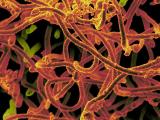Aug 9, 2007 (CIDRAP News) Dengue fever is gaining a firmer foothold in southern Texas, putting residents at risk for the most dangerous form of the disease, dengue hemorrhagic fever (DHF), the Centers for Disease Control and Prevention (CDC) reported today.
A dengue outbreak in the Brownsville, Tex., area in 2005 involved 25 hospital cases, 16 of which were classified as DHF, the CDC reports in the Aug 10 issue of Morbidity and Mortality Weekly Report.
Dengue fever is a mosquito-borne viral disease found in most tropical and subtropical regions of the world. The virus occurs in four serotypes, and infection with any one of these induces immunity only to that serotype, according to the CDC. A second infection with a different serotype increases a person's risk for DHF, which involves bleeding and the possibility of life-threatening shock.
The 2005 outbreak in the Brownsville area was heralded by a DHF case in a Brownsville woman who fell ill in late June. When she was hospitalized there, doctors missed the dengue diagnosis, even though her clinical characteristics met World Health Organization (WHO) criteria for DHF. Eventually the diagnosis was made through serum testing by the Texas Border Infectious Disease Surveillance project.
The CDC says the woman's illness marked the first DHF case in a Texas resident native to the Texas-Mexico border area. A locally acquired DHF case in the area was reported in 2004, but the patient was originally from Southeast Asia and probably had acquired her first dengue infection there, the report says.
About 2 months after the Brownsville woman's case, in late August of 2005, Mexican health officials in Tamaulipas state, across the border from Brownsville, told their Texas counterparts that a dengue fever outbreak in the state had grown to 1,251 cases. Those included 223 cases (17.8%) classified as DHF. In the previous 5 years, 541 dengue cases, including just 20 DHF cases, had been reported in the state.
Health officials on both sides of the border subsequently increased their surveillance for dengue cases, the report says. In December, officials reviewed the medical records of 129 patients who had been hospitalized with evidence of dengue fever, including 25 patients in Cameron County, Tex., and 104 treated in Matamoros, Mexico.
No deaths were reported, but 16 of the 25 Cameron County cases and 34 of the 104 Matamoros cases met the WHO criteria for DHF. (More thorough lab testing of the US cases may have accounted for the higher proportion of DHF found there, the report notes.) Eleven of the 50 DHF cases were classified as WHO grade III, or dengue shock syndrome, with "early or mild evidence of hypotension or shock," and the rest were listed as grade II.
Since many dengue infections are asymptomatic or do not prompt the person to seek medical care, health investigators also conducted serologic surveys in Brownsville and Matamoros, the report says.
In Matamoros, 101 of 131 people tested had IgG antibodies to dengue, signaling a weighted prevalence of 76.6%. In Brownsville the investigators found IgG antibodies in 47 of 141 people tested, for a weighted prevalence of 38.2%.
"Entomologic, serologic and virologic conditions are now such that locally acquired DHF can occur in south Texas," the CDC asserts. Two mosquito species that spread the virus, Aedes aegypti and Aedes albopticus, are well established there.
The report adds, "The finding that 38% of surveyed Brownsville residents have IgG antibodies to dengue indicates that a substantial proportion of the city population has been infected with the dengue virus and might be more susceptible to DHF if they receive a second infection" with a different serotype.
Clinicians and the public in southern Texas should be aware of the risk of dengue and DHF, the CDC advises. "Early recognition and diagnosis of DHF and careful fluid management can reduce the case-fatality rate in cases with shock to less than 1%," the report states.
CDC. Dengue hemorrhagic feverU.S.-Mexico border, 2005. MMWR 2007 Aug 10;56(31):785-9 [Full text]



















